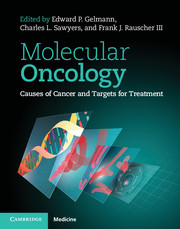Book contents
- Frontmatter
- Dedication
- Contents
- List of Contributors
- Preface
- Part 1.1 Analytical techniques: analysis of DNA
- Part 1.2 Analytical techniques: analysis of RNA
- Part 2.1 Molecular pathways underlying carcinogenesis: signal transduction
- 10 HER
- 11 The insulin–insulin-like growth-factor receptor family as a therapeutic target in oncology
- 12 TGF-β signaling in stem cells and tumorigenesis
- 13 Platelet-derived growth factor
- 14 FMS-related tyrosine kinase 3
- 15 ALK: Anaplastic lymphoma kinase
- 16 The FGF signaling axis in prostate tumorigenesis
- 17 Hepatocyte growth factor/Met signaling in cancer
- 18 PI3K
- 19 Intra-cellular tyrosine kinase
- 20 WNT signaling in neoplasia
- 21 Ras
- 22 BRAF mutations in human cancer: biologic and therapeutic implications
- 23 Aurora kinases in cancer: an opportunity for targeted therapy
- 24 14-3-3 proteins in cancer
- 25 STAT signaling as a molecular target for cancer therapy
- 26 The MYC oncogene family in human cancer
- 27 Jun proteins and AP-1 in tumorigenesis
- 28 Forkhead box proteins: the tuning forks in cancer development and treatment
- 29 NF-κB and cancer
- Part 2.2 Molecular pathways underlying carcinogenesis: apoptosis
- Part 2.3 Molecular pathways underlying carcinogenesis: nuclear receptors
- Part 2.4 Molecular pathways underlying carcinogenesis: DNA repair
- Part 2.5 Molecular pathways underlying carcinogenesis: cell cycle
- Part 2.6 Molecular pathways underlying carcinogenesis: other pathways
- Part 3.1 Molecular pathology: carcinomas
- Part 3.2 Molecular pathology: cancers of the nervous system
- Part 3.3 Molecular pathology: cancers of the skin
- Part 3.4 Molecular pathology: endocrine cancers
- Part 3.5 Molecular pathology: adult sarcomas
- Part 3.6 Molecular pathology: lymphoma and leukemia
- Part 3.7 Molecular pathology: pediatric solid tumors
- Part 4 Pharmacologic targeting of oncogenic pathways
- Index
- References
13 - Platelet-derived growth factor
from Part 2.1 - Molecular pathways underlying carcinogenesis: signal transduction
Published online by Cambridge University Press: 05 February 2015
- Frontmatter
- Dedication
- Contents
- List of Contributors
- Preface
- Part 1.1 Analytical techniques: analysis of DNA
- Part 1.2 Analytical techniques: analysis of RNA
- Part 2.1 Molecular pathways underlying carcinogenesis: signal transduction
- 10 HER
- 11 The insulin–insulin-like growth-factor receptor family as a therapeutic target in oncology
- 12 TGF-β signaling in stem cells and tumorigenesis
- 13 Platelet-derived growth factor
- 14 FMS-related tyrosine kinase 3
- 15 ALK: Anaplastic lymphoma kinase
- 16 The FGF signaling axis in prostate tumorigenesis
- 17 Hepatocyte growth factor/Met signaling in cancer
- 18 PI3K
- 19 Intra-cellular tyrosine kinase
- 20 WNT signaling in neoplasia
- 21 Ras
- 22 BRAF mutations in human cancer: biologic and therapeutic implications
- 23 Aurora kinases in cancer: an opportunity for targeted therapy
- 24 14-3-3 proteins in cancer
- 25 STAT signaling as a molecular target for cancer therapy
- 26 The MYC oncogene family in human cancer
- 27 Jun proteins and AP-1 in tumorigenesis
- 28 Forkhead box proteins: the tuning forks in cancer development and treatment
- 29 NF-κB and cancer
- Part 2.2 Molecular pathways underlying carcinogenesis: apoptosis
- Part 2.3 Molecular pathways underlying carcinogenesis: nuclear receptors
- Part 2.4 Molecular pathways underlying carcinogenesis: DNA repair
- Part 2.5 Molecular pathways underlying carcinogenesis: cell cycle
- Part 2.6 Molecular pathways underlying carcinogenesis: other pathways
- Part 3.1 Molecular pathology: carcinomas
- Part 3.2 Molecular pathology: cancers of the nervous system
- Part 3.3 Molecular pathology: cancers of the skin
- Part 3.4 Molecular pathology: endocrine cancers
- Part 3.5 Molecular pathology: adult sarcomas
- Part 3.6 Molecular pathology: lymphoma and leukemia
- Part 3.7 Molecular pathology: pediatric solid tumors
- Part 4 Pharmacologic targeting of oncogenic pathways
- Index
- References
Summary
Introduction
Platelet-derived growth factor (PDGF) constitutes a family of disulfide-linked dimeric growth factors that promote cell growth and migration by activation of tyrosine kinase PDGFα- and β-receptors (1). PDGFs act predominantly on mesenchymal cells, such as fibroblasts, pericytes, and smooth muscle cells, and are also potent regulators of glial cells. In the context of tumor biology, PDGF isoforms act as autocrine factors for malignant cells, and as stimulators of fibroblasts and pericytes in the tumor stroma. Clinical studies have validated PDGF receptors, expressed on malignant cells or on cells of the tumor stroma, as relevant cancer drug targets (2).
Structure of PDGF and PDGF receptors
PDGF is a family of disulfide-bounded homodimers of homologous A-, B-, C-, and D-polypeptide chains. In addition, the A- and B-chains form a heterodimer PDGF-AB. The two subunits in the dimer are arranged in an anti-parallel manner, creating two symmetric receptor binding epitopes. The PDGF isoforms show sequence similarly to vascular endothelial cell growth factors (VEGFs). In addition, PDGFs, VEGFs, and transforming growth factor-β (TGF-β) show a similar folding with a cystine-knot structure (1).
- Type
- Chapter
- Information
- Molecular OncologyCauses of Cancer and Targets for Treatment, pp. 135 - 143Publisher: Cambridge University PressPrint publication year: 2013

